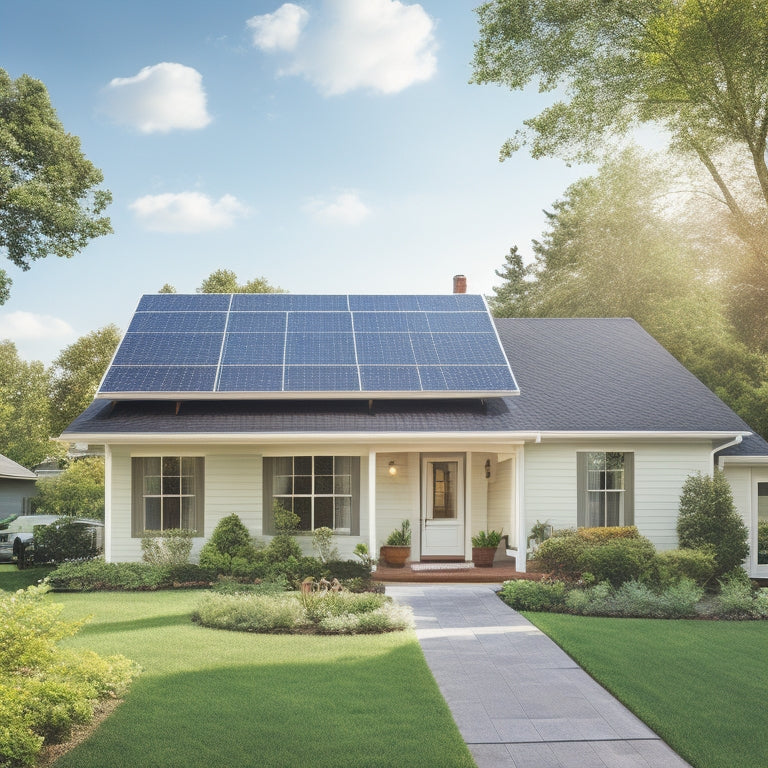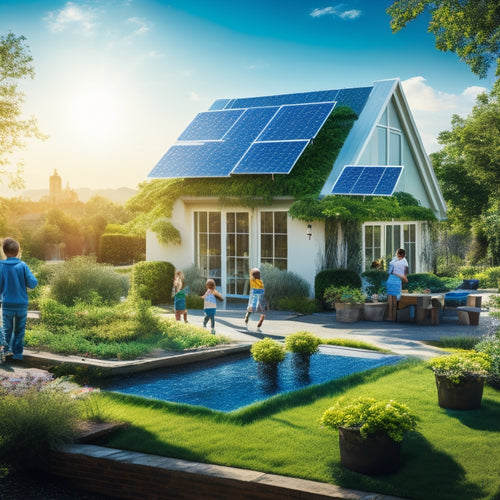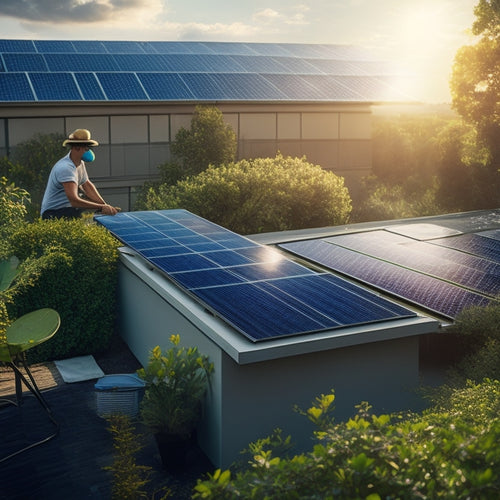
What to Consider for the Average Cost of Solar Panels
Share
When considering the average cost of solar panels, you'll want to factor in the system's size and quality, as larger, more efficient systems produce more electricity but come with higher costs. Your roof's size, orientation, and material will also impact installation and energy output. The installer's proficiency, labor costs, and local incentives can greatly influence the overall cost. Additionally, energy storage solutions, permits, and maintenance needs will add to the expense. By understanding these key factors, you'll be able to traverse the complex terrain of solar panel pricing and make an informed decision about your investment - and there's more to investigate.
Key Takeaways
- System size and quality impact the cost of solar panels, with larger and more efficient systems typically being more expensive.
- Roof characteristics, including size, orientation, and material, affect installation costs and energy output.
- Installation costs vary depending on installer expertise, labor costs, and location, with certified installers often charging more.
- Financial incentives, such as local rebates, federal tax credits, and state incentives, can significantly reduce the cost of solar panels.
- Energy storage solutions, permits, and maintenance costs should be factored into the overall cost of solar panels, as they can add significant expense.
System Size and Quality Matter
Considering your solar panel investment, system size and quality are essential factors that greatly impact the overall cost.
You'll want to balance the two to guarantee you're generating enough power for your needs while keeping costs in check. A larger system will generally produce more electricity, but it will also be more expensive. On the other hand, a higher-quality system with more efficient panels will produce more power per unit, but it will also come at a higher upfront cost.
When evaluating system quality, panel efficiency is a critical consideration. More efficient panels can generate more power in the same amount of space, making them a better value in the long run.
Look for panels with high efficiency ratings, typically above 20%. Additionally, consider the type of solar technology used in the panels. Monocrystalline silicon panels, for example, are more efficient than polycrystalline silicon panels.
Ultimately, you'll need to weigh the benefits of a larger, more efficient system against the higher upfront cost.
Roof Size and Orientation Impact
When evaluating your solar panel installation, you'll find that roof size matters: a larger roof can accommodate more panels, increasing overall energy production.
However, the orientation of your roof also affects output, as panels installed on south-facing roofs receive more direct sunlight and generate more energy.
Roof Size Matters
Your roof's dimensions play a crucial role in determining the number of solar panels you can install and the amount of energy they can generate. The size of your roof affects the number of panels that can fit, which in turn impacts the system's overall energy production. A larger roof provides more space for panels, allowing you to generate more electricity.
However, even a large roof can have limitations due to obstacles like skylights, vents, and chimneys.
To maximize energy production, it's important to conduct a thorough shading analysis to identify areas that receive the most sunlight. This analysis helps you determine the best placement of panels to minimize energy losses.
Additionally, the type of roof materials you have can affect the installation process and overall cost. For instance, asphalt shingle roofs are generally easier to install on than metal or clay tile roofs.
Orientation Affects Output
The orientation of your roof greatly impacts the energy output of your solar panel system. When evaluating your roof's suitability for solar panels, it's vital to take into account the direction it faces and the angle at which it's pitched.
Ideally, your roof should receive direct sunlight exposure for the majority of the day. South-facing roofs with a pitch between 30 and 40 degrees are regarded as ideal, as they can maximize energy production.
However, if your roof doesn't meet these criteria, it's not the end of the world. You can still achieve decent energy output with a bit of creativity. For instance, you can adjust the panel angle to compensate for a less-than-ideal roof orientation. This might require additional installation costs, but it can appreciably enhance energy production.
Keep in mind that even with ideal orientation and panel angle, shading from trees, buildings, or other obstructions can still affect energy output.
It's crucial to evaluate your roof's specific conditions and adjust your solar panel system accordingly to maximize energy production.
Installation Company and Labor Costs
When you're shopping for a solar panel installation company, you'll want to evaluate the installer's proficiency level, as a more experienced team will typically charge higher labor rates.
You'll need to factor in the labor hourly rate, which can range from $50 to $150 per hour, depending on the company's reputation and the complexity of the installation.
The total labor cost will depend on the number of hours required to complete the job, which can vary considerably depending on the size and complexity of your solar panel system.
Installer's Expertise Level
Typically, homeowners find that installation company and labor costs account for a significant portion of their total solar panel expenses. One vital factor that affects these costs is the installer's skill level. You'll want to guarantee that the installation company you choose has experienced and qualified professionals to handle the job.
| Installer Qualifications | Experience Levels |
|---|---|
| NABCEP Certification | 5+ years of experience |
| Advanced Training in Solar Installation | 3-5 years of experience |
| Basic Training in Solar Installation | 1-3 years of experience |
| No Certification or Training | Less than 1 year of experience |
| Manufacturer-Certified Installers | Varies by manufacturer |
When evaluating an installer's skill level, look for certifications like NABCEP, advanced training, and manufacturer certifications. These indicate a higher level of competence and quality of work. Experienced installers can guarantee a smooth and efficient installation process, which can ultimately save you money and reduce the risk of errors. Be wary of installers with little to no experience or training, as they may not provide the same level of quality and reliability.
Labor Hourly Rate
You've shortlisted installation companies with experienced and qualified professionals, now it's time to assess their labor costs. The labor hourly rate is a significant factor in the overall cost of solar panels. It varies depending on the installation company's location, size, and complexity of the project. Labor market trends and regional wage differences also play an important role in determining the hourly rate.
For instance, installation companies in urban areas tend to have higher labor costs due to higher living costs and a more competitive labor market. In contrast, companies in rural areas may have lower labor costs. Additionally, companies with more complex projects requiring specialized skills may charge higher hourly rates.
When evaluating labor costs, ask potential installers about their hourly rate, the number of hours required to complete the project, and the total labor cost. Be sure to compare rates among different installers to find the best value for your money.
Local Incentives and Rebates Available
The cost of solar panels can be greatly reduced with local incentives and rebates, which vary by state and even municipality.
You'll want to research what's available in your area to maximize your savings. Federal tax credits, for instance, can cover up to 26% of your solar panel system's cost.
Additionally, many states offer their own incentives, such as tax credits, rebates, or property tax exemptions. Some utilities and municipalities even provide rebates or discounts for solar panel installations.
You may also be eligible for special financing options or low-interest loans. When calculating the average cost of solar panels, be sure to factor in these local incentives and rebates.
You can check with your local government, utility company, or a solar panel professional to get a thorough list of incentives available in your area.
Battery Backup and Energy Storage
As you consider the average cost of solar panels, incorporating battery backup and energy storage into your system can greatly enhance its functionality and value.
With a battery storage system, you'll enjoy energy independence, guaranteeing you have power even during grid outages. When the grid is online, your system can store excess energy generated by your solar panels for later use, reducing your reliance on the grid connection.
When selecting a battery, consider the battery lifespan, which typically ranges from 5 to 15 years. Look for system compatibility to guarantee seamless integration with your existing setup.
Technological advancements have made energy storage more efficient and affordable, offering significant cost savings in the long run. Additionally, opting for energy storage reduces your environmental impact by minimizing your reliance on fossil fuels.
You have various installation options to choose from, including whole-home backup systems or smaller, more targeted solutions.
Permits and Inspection Fees Add Up
Beyond the hardware costs of your solar panel system, permits and inspection fees can greatly add to your overall expense.
You'll need to obtain various permits from local authorities, including electrical and building permits, before installing your solar panel system. These permits guarantee your system meets safety and electrical codes. The cost of permits varies by region, but you can expect to pay between $500 to $2,000, depending on your location and system size.
Inspection requirements also vary by region, but you'll typically need to pass multiple inspections during the installation process. These inspections confirm that your system meets local building codes and safety standards.
You may need to pay for multiple inspections, which can add up quickly. On average, inspection fees range from $100 to $500 per inspection.
When budgeting for your solar panel system, be certain to factor in these additional costs to get an accurate estimate of your total expense. By understanding the permit types and inspection requirements in your area, you can better plan for these added expenses and guarantee a smooth installation process.
Monitoring and Maintenance Needs
Your solar panel system is a complex network of components that require regular monitoring and maintenance to guarantee peak performance and extend its lifespan.
To secure ideal energy consumption, you'll need to invest in monitoring technology that tracks your system's performance and alerts you to any issues.
Here are three essential maintenance tasks to prioritize:
-
Regular cleaning: Dust and debris can reduce your system's energy output. Schedule regular cleanings to maintain peak performance.
-
System upgrades: As technology advances, upgrading your system can improve its efficiency and extend its lifespan.
-
Troubleshooting processes: Establish a maintenance schedule that includes regular checks for faults and malfunctions, securing prompt resolution and minimizing downtime.
Remember to review your warranty coverage and factor in the cost of maintenance when calculating the average cost of solar panels.
A well-maintained system will provide you with a reliable source of power for years to come.
Frequently Asked Questions
Do Solar Panels Work During Power Outages Without a Battery?
You'll find that solar panels don't work during power outages without a battery, as they're designed to sync with the grid's frequency, and grid connection limitations prevent them from operating independently, even with high solar panel efficiency.
Can I Install Solar Panels on a Metal or Clay Roof?
You'll face unique installation challenges with metal or clay roofs, but it's possible; you'll need specialized fastening systems and a thorough assessment of roof compatibility to guarantee a secure and efficient solar panel installation that meets your power needs.
Are Solar Panels Resistant to Hail and Extreme Weather?
Ha! You think a little hail is gonna take down your solar panel game? Think again! You'll be relieved to know that most solar panels are built to withstand extreme weather, boasting impressive durability and resistance to hail, heavy snow, and even hurricane-force winds.
Can I Sell Excess Energy Back to the Grid?
You can sell excess energy back to the grid through net metering, earning energy credits that offset your utility bills; this benefit allows you to maximize your solar investment and reduce your reliance on the grid.
Do Solar Panels Increase My Property Value?
Curiously, a study coincidentally found that you'll likely see a significant increase in your property value with solar panels, thanks to solar panel incentives and a substantial return on investment, making your eco-friendly move a smart financial decision.
Conclusion
As you weigh the costs of going solar, remember that every factor counts. From system size and quality to installation company and local incentives, each aspect affects your bottom line. Notably, according to the National Renewable Energy Laboratory, the cost of solar panels has dropped by 70% over the last decade, making it a more viable option for homeowners. By considering these key factors, you'll be well-equipped to make an informed decision about investing in solar energy for your home.
Related Posts
-

Solar Energy Benefits for Sustainable Living
Solar energy provides numerous benefits for sustainable living that you can't overlook. By switching to solar, you'll...
-

Green Ways to Maintain Solar Panels
To maintain your solar panels sustainably, start with regular inspections to catch potential issues early, enhancing ...
-

Energy-Efficient Home Upgrades for Cost Reduction
To reduce costs with energy-efficient home upgrades, focus on essential improvements like smart thermostats, energy-e...


